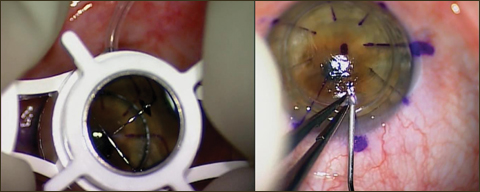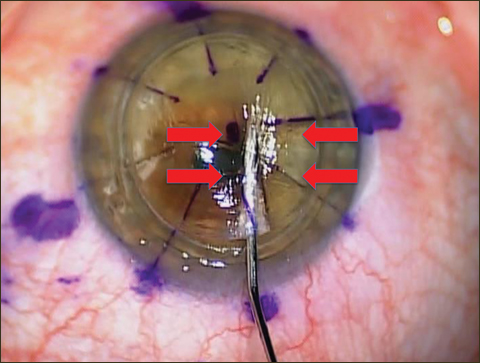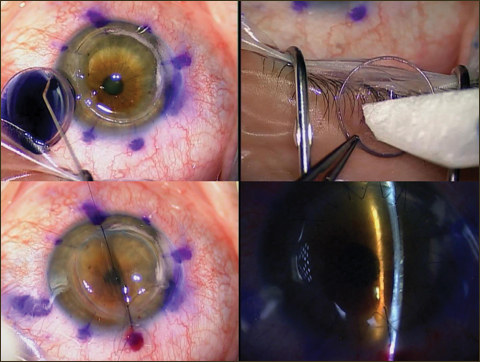Air pumping technique simplifies DALK, increases rate of big bubble creation
The technique also focuses on separating diseased corneal stroma from Descemet's membrane and preventing host Descemet's membrane tears.
Lamellar keratoplasty encompasses both anterior lamellar keratoplasty and posterior lamellar keratoplasty. This form of transplantation technique is called selective corneal transplantation, in which only the diseased portions of the cornea are removed and replaced with similar layers of healthy donor corneal tissue, thus retaining the healthy regions of the recipient cornea.
There are several benefits of selective corneal transplantation, the most important being the negation of endothelial corneal graft rejection. Figure 1 shows the John-Malbran lamellar keratoplasty classification that was introduced in 2006; it is based on the amount of recipient cornea that is removed and replaced, and it includes superficial anterior lamellar keratoplasty, mid anterior lamellar keratoplasty, deep anterior lamellar keratoplasty and total anterior lamellar keratoplasty. In performing anterior lamellar keratoplasty, the surgeon needs to be familiar with more than one technique so that he is able to change technique as needed during surgery to complete cases that may be more complex and challenging.
In this column, I describe the challenges of DALK and how to simplify the technique and complete the procedure with less chance of tearing the host Descemet’s membrane.
Surgical technique
The challenges of DALK mainly focus on the reproducible creation of the big bubble (Figure 2); separation of the diseased corneal stroma from the Descemet’s membrane; and prevention of tears in the host Descemet’s membrane. I will review these areas of the surgical procedure and provide some avenues that may help augment the success rate of this procedure.

Images: John T





Figure 6. The big bubble is entered into using the tip of a 15° superblade.

Figure 7. Viscoat injection into this space separates the inner corneal stroma from the external surface of the Descemet’s membrane.




Figure 11. Intraoperative illuminating ring light is used to control corneal astigmatism by suture tension adjustment and suture addition as needed.

Figure 12. Completed intraoperative view of the DALK procedure.
1. Reproducible big bubble. The big bubble refers to air separation of the recipient corneal stroma from the native Descemet’s membrane. When the big bubble is attained, it makes DALK easier and quicker to remove the stroma, leaving the intact Descemet’s membrane. The air pumping technique utilizes a single instrument, a bent 27-gauge needle on an air-filled syringe. It eliminates the need for the two-instrument procedure of the tracker followed by a blunt cannula technique. Corneal trephination is performed using the surgeon’s choice of trephine to 90% of preoperative OCT corneal thickness (Figure 3). The bent needle is introduced through the trephination cut into deep corneal stroma, advancing the needle tip to the paracentral region of the cornea (Figures 3 to 5). The knee of the bent needle is then raised toward the ceiling, and the bevel of the needle that faces the floor is pressed down against the stroma to ensure a tight bevel contact to the deep stroma (Figure 4). Air is then injected in spurts (Figure 5), much like the old-fashioned way of pumping air into a bicycle tire. This pumping action then gradually in a stepwise fashion elevates and separates the stroma from the Descemet’s membrane, thus creating the big bubble (Figure 5). This step is terminated when the big bubble reaches the trephination circle (Figure 5). This air pumping technique simplifies DALK surgery and increases the rate of big bubble creation.
2. Separation of diseased corneal stroma from Descemet’s membrane. Upon successful creation of the big bubble, a superblade is used to enter this space (Figure 6). Viscoelastic on the corneal surface can help control the rate of air egress from the big bubble. Following anterior chamber decompression, Viscoat (chondroitin sulfate and sodium hyaluronate, Alcon) injection into this space separates the inner corneal stroma from the external surface of the Descemet’s membrane (Figure 7). Next, the stroma is excised in a segmental manner until the bare Descemet’s membrane is displayed (Figure 8).
3. Prevention of host Descemet’s membrane tears. The size of the 27-gauge needle for big bubble creation is small, and hence, even if the anterior chamber is accidentally entered, it only creates a puncture wound and not a larger Descemet’s membrane tear as with the two-instrument system. The needle can then be retracted, and a new site is chosen for the air injection. The puncture wound self-seals and is no longer an issue with the rest of the procedure. The use of John ALK scissors (ASICO) can protect the Descemet’s membrane from accidental tears. The distal circular disc pushes the Descemet’s membrane away from the blades and prevents accidental Descemet’s membrane tear. When using Vannas scissors, always lift the corneal stroma away from the Descemet’s membrane and keep the blade tip facing up to prevent accidental tear of the Descemet’s membrane (Figure 9).
4. Completion of the procedure. VisionBlue (trypan blue ophthalmic solution 0.06%, DORC/Dutch Ophthalmic USA) helps stain the donor endothelium and the Descemet’s membrane and enhances visualization, thus facilitating their removal (Figure 10). The donor disc is attached to the recipient Descemet’s membrane by using initial tight sutures that uniformly approximate the donor corneal stroma to the recipient Descemet’s membrane without any false chamber formation (Figure 10). Intraoperative slit lamp view confirms uniform approximation of the donor corneal disc to the recipient Descemet’s membrane (Figure 10). A surgical illuminating ring light (Mastel) (Figure 11) helps control corneal astigmatism by suture tension adjustment and suture addition as needed. The completed intraoperative view of the DALK procedure is shown in Figure 12.
Surgical pearls
1. Introduce the bent 27-gauge needle within the deep corneal stroma close to the Descemet’s membrane. If accidental perforation occurs and air is injected into the anterior chamber, then withdraw the needle and reinject air at a new site. Because the 27-gauge needle perforation is small, it is almost negligible and has few deleterious effects in DALK surgery.
2. Before injecting air, ensure good needle position by lifting the knee of the needle up and pressing the needle tip bevel facing down into the stroma.
3. Inject air in spurts and notice the creation of the big bubble, being prepared to stop when it reaches the trephination mark. Try to avoid going beyond the trephination mark because this will compromise the peripheral view into the anterior chamber.
- References:
- Agarwal A, John T, eds. Mastering Corneal Surgery: Recent Advances and Current Techniques. Thorofare, NJ: SLACK Incorporated; 2015.
- Chen G, et al. Cornea. 2016; doi:10.1097/ICO.0000000000000691.
- de Sanctis U, et al. Int J Ophthalmol. 2016;doi:10.18240/ijo.2016.01.08.
- John T, ed. Surgical Techniques in Anterior and Posterior Lamellar Keratoplasty. New Delhi, India: Jaypee Brothers Medical Publishers; 2006.
- John T, ed. Step by Step Anterior and Posterior Lamellar Keratoplasty. New Delhi, India: Jaypee Brothers Medical Publishers; 2006.
- John T, ed. The Chicago Eye and Emergency Manual. Panama City, Panama: Jaypee-Highlights Medical Publishers; 2011.
- For more information:
- Thomas “TJ” John, MD, is a clinical associate professor at Loyola University at Chicago and in private practice in Oak Brook, Tinley Park and Oak Lawn, Ill. He can be reached at email: tjcornea@gmail.com.
Disclosure: John reports he receives a small royalty from ASICO and Jaypee-Highlights Medical Publishers.
